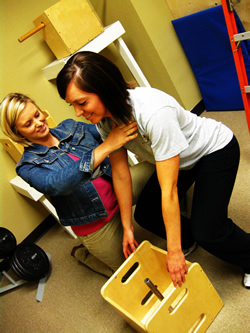
Work Conditioning and Work Hardening are constantly intermixed and/or misunderstood as being the same thing, but they aren’t.
Work Hardening
Work Hardening is a highly structured, goal-oriented, individualized intervention program designed to return the patient/client to work. It uses real or simulated work activities designed to restore physical, behavioral, and vocational functions. It is multidisciplinary in nature using physical therapist, occupational therapist, psychologist, and vocational specialist. It usually is daily and up to 8 weeks (chronic) or 20-25 visits up to 6 weeks (sub acute).
Work Conditioning
Work Conditioning is an intensive, work-related, goal oriented conditioning program designed to specifically restore neuromuscular and musculoskeletal function including strength, power, endurance, joint mobility, range of motion (ROM), motor control, cardiovascular endurance and functional abilities. It is an alternative to Work Hardening for those who do not need behavioral/pain management or vocational interventions. It usually is 3-5 times/week for up to 8 weeks (chronic) or 20-25 visits up to 6 weeks (sub acute).
A true Work Hardening program is very hard to find and most Work Conditioning/Hardening programs are truly Work Conditioning programs so I’m going to describe what to expect in a Work Conditioning program. Hopefully a patient has received specific physical or occupational therapy services that include but are not limited to manual therapy such as soft tissue mobilization, joint mobilization, guided exercises, home exercise programs, stretching, strengthening, pain control using electrical stimulation, and heat or ice as warranted. Typically criteria of an appropriate patient for a Work Conditioning program are the following:
- Patient has a work related injury as determined by a physician.
- Has a prescription from a physician for the Work Conditioning program and an accompanying work related musculoskeletal disorder (WMSD) diagnosis.
- Medically stable and no longer in the acute phase of injury.
- Able to successfully perform functional ROM without increase in pain.
- Able to demonstrate minimum strength of 4-/5.
- Goal of getting back to work full-time.
A Functional Baseline is the beginning step of a good Work Conditioning program, and it is used to:
- determine the patient’s current physical demand level (sedentary, light, medium, heavy, or very heavy)
- determine classification of aerobic capacity (poor, fair, average, good, excellent)
- determine Grip strength (with injuries involving neck or upper extremity or jobs involving a lot of simple or firm grasping)
- musculoskeletal screen (current objective date; AROM; core and joint specific strength)
The Functional Baseline is then compared to the patient’s job description to create the job specific program that will focus on improving work specific and functional ROM, work specific and functional strength, work and positional endurance, and ultimately returning the patient to work safely.
The Work Conditioning sessions are typically 3-4 hours each treatment and 2-5 days per week, depending on the needs of the injured worker. The sessions should include stretching, positional strengthening and tolerances, joint specific and work specific strengthening, core strengthening/stabilization to assist with safe lifting, cardiovascular conditioning to work endurance, tasks specific manipulations, job specific lifting and carrying, education (postural awareness, lifting mechanics, importance of micro-stretching throughout workday, awareness of awkward positions, and vibrations), and a home exercise program (HEP).
The goals of a Work Conditioning program are to decrease a patient’s fear of returning to work, restore a patient’s physical capacity and function to enable a safe full duty full time return to work (RTW), for the injured worker to be able to self manage symptoms, and prevent recurrence of the same injury or any injury.

